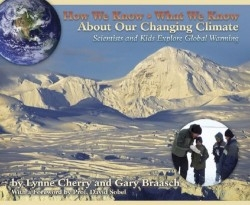How We Know What We Know About Our Changing Climate
- 2008 INDIES Winner
- Gold, Environment (Adult Nonfiction)
When students at a Vermont middle school noticed that breathing the air made them feel ill, they also realized the buses sat outside with idling motors mornings and afternoons. Upon discovering that the fumes contained twelve different pollutants, they petitioned the school board for a “no-idling” policy. In February 2007, it became a state law. That’s the kind of environmental awareness promoted in this very timely book. By using science, fourth through ninth graders are introduced to the world around them in How We Know What We Know About Our Changing Climate.
An award-winning children’s author and illustrator of more than thirty books, Cherry wrote the classic The Great Kapok Tree: A Tale of the Amazon Rain Forest eighteen years ago. Nature is a theme prevalent in later books as well, including Flute’s Journey: The Life of a Wood Thrush and How the Groundhog’s Garden Grew.
Braasch, a photojournalist for over thirty years, takes the photos illustrating his nature articles for such magazines as National Geographic, Audubon, and Scientific America. His photos told the story in his recently published book for adults, Earth Under Fire: How Global Warming is Changing the World.
Cherry and Braasch have combined their talents to show a younger demographic how to “read” the science at their fingertips. In two-page segments, they examine how the changing elements may be affecting birds, flowers, butterflies, the ocean’s “conveyor belt” (the Gulf Stream), and the coastlines.
In kid-friendly language, the authors incorporate the work of nearly forty-five scientists into easily-understood reads, ranging from Dr. Camille Parmesan’s information on the Edith’s checkerspot butterfly, to Dr. Lloyd Keigwin, who studies ancient ocean mud cores. The authors also make it a point to showcase students, termed “citizen scientists,” who assist in various national conservation programs within their schools.
Readers are assisted with unfamiliar words. Nearly sixty-five terms are italicized, with their meaning immediately and comfortably defined. For example, in the section entitled “Penguins and Polar Bears in a Changing World of Ice,” a major food source is mentioned: “krill, a small shrimp-like creature that swims in huge schools.”
Braasch took more than half of the photographs that accompany the text, and there are at least two photos per two-page section. The last four pages list numerous resources, including Web sites and books. A teacher’s guide is also available.
The authors seem to lead by example since the book itself is “a product of sustainable forestry practices.” They also stand by an old saying: “We do not inherit the Earth from our ancestors, we borrow it from our children.”
Reviewed by
Robin Farrell Edmunds
Disclosure: This article is not an endorsement, but a review. The publisher of this book provided free copies of the book to have their book reviewed by a professional reviewer. No fee was paid by the publisher for this review. Foreword Reviews only recommends books that we love. Foreword Magazine, Inc. is disclosing this in accordance with the Federal Trade Commission’s 16 CFR, Part 255.

